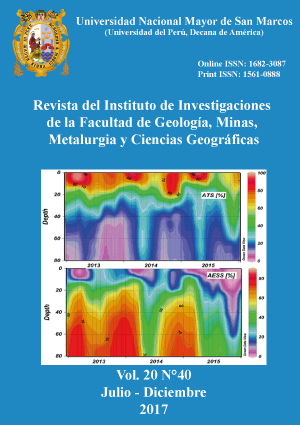Quality of liquid effluents in the process of optimization of cooling towers of the zinc refinery of Cajamarquilla, period 2013 to 2014
DOI:
https://doi.org/10.15381/iigeo.v20i40.14401Keywords:
Quality, liquid effluents, 3D technology Trasar, optimization, cooling towersAbstract
At the Cajamarquilla zinc refinery, the cooling systems of cooling towers No. 1 (160 K and tower tech) and No. 2 (320K) as any cooling system present problems of corrosion, incrustation, accumulation of impurities and microorganisms Which are in contact with water quality from other areas, such as roasting, sulfuric acid plant, hydrometallurgy, among others. With the research carried out, clean and modern technologies were applied to optimize the operation of the cooling towers, which made possible a better quality of the liquid effluent and the reduction of water use from the purges of these refrigeration systems that are treated and Discharged to the sewage network, then discharged to the “Poza de Retención” and finally to the “Poza de Regantes” located to the south of the Cajamarquilla refinery owned by the irrigation association of the “Jicamarca” valley.
In this sense, the optimization of the cooling systems of the cooling towers N°. 1 (160K and Tower Tech) and N°. (320K) consisted of a first phase in the conditioning of lines with the diversion towards the plant pH 9 with The purpose of reducing the content of zinc and solids in suspension and achieving a better level of efficiency, obtaining effluents with the minimum concentrations of metals and allowing discharge to the receiving body, does not cause any adverse effects on the components of the ecosystem. The second phase consisted of the study and application of modern technologies in refrigeration systems, such as the “3D Trasar Technology”, which helped to detect, determine and avoid incrustations, corrosion and microbiological activity, as well as control and monitor the supply water ( Make Up) and purge cooling towers automatically, also improved the instrumentation of the main liquid effluent quality variables, allowing the control and continuous monitoring in real time of control parameters such as: Hydrogen ion potential , Conductivity, turbidity, fouling of the cell, temperature, flow, among others.
The third phase was to improve the chemical treatment of cooling towers by replacing the corrosion inhibitor “Nalco 8575” and the incrustation inhibitor (“Nalco 8300”) by “Nalco 3DT 187” and “Nalco 3DT 198” respectively.
The results obtained indicate that in the period 2013 to 2015 there is a reduction of water use of 50.86%, with concentration cycles of 2.37 to 3.03 respectively; In the years 2013 and 2014 a decrease in the zinc content at the outlet of the tower was achieved in 6.35% from 2.52 mg / L to 2.36 mg / L. It should be mentioned that the reliability of the samples made has been based on the “Water Quality Monitoring Protocol subsector mining”, the criteria of national and international environmental legal standards such as the Maximum Permissible Limits (LMP) and the Standards National Water Quality Standards (ECA) for Category III, the latter being the environmental legal referent. The internal laboratory of the Cajamarquilla Refinery was also taken into account, under the accreditation of ISO 17025 and external laboratories accredited by the National Institute of Quality (INACAL), in addition to having the ISO 14001 standard, all of which focused on To the integrated management system “SGV”.
Downloads
Published
Issue
Section
License
Copyright (c) 2017 Wilmer Silva Rivera, Vidal Aramburú Rojas

This work is licensed under a Creative Commons Attribution-NonCommercial-ShareAlike 4.0 International License.
AUTHORS RETAIN THEIR RIGHTS:
a. Authors retain their trade mark rights and patent, and also on any process or procedure described in the article.
b. Authors retain their right to share, copy, distribute, perform and publicly communicate their article (eg, to place their article in an institutional repository or publish it in a book), with an acknowledgment of its initial publication in the Rev. Inst. investig. Fac. minas metal cienc. geogr.
c. Authors retain theirs right to make a subsequent publication of their work, to use the article or any part thereof (eg a compilation of his papers, lecture notes, thesis, or a book), always indicating the source of publication (the originator of the work, journal, volume, number and date).






